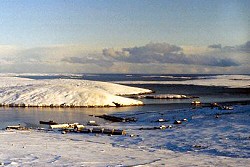 |
The Island of Yell |
 |
 Yell – Jala in the Norse sagas – the second largest island in the group, lies just north of the Shetland Mainland.
Unlike its near neighbours Fetlar and Unst, which are very interesting geologically, Yell’s bedrock is grey schist, which in many places has re-crystallized into gneiss. Many garnets are found on Yell, but although some are quite large, they are too frail to be polished for jewellery. The type of rock described leads to poor drainage and explains why in Yell’s interior the peat can be up to 7 metres deep in places.
The poor drainage also explains why the population is only about 1,000, and that the majority live around the sheltered inlets (voes). In Yell, as in many other Shetland Islands, a living has always had to be found from the sea. In spite of these disadvantages the population is stable and today have quite a high standard of living.
Yell has a leisure centre, a care home and almost all village halls and churches have been renovated, all thanks to the Charitable Trust, which was set up in the 1970s using oil disturbance funds.
The heathery moors of Yell are a haven for many breeding birds. The swamps and small lochs of the interior of the island are home to divers and ducks and during the last decade greylag geese have colonised the north of Shetland. Great skuas, although unwelcome because of their habit of taking the young of several species, nest on the moors.
The calls of the breeding waders such as curlew, whimbrel, plover and dunlin are delightful. An added bonus would be the call of a merlin at its nest but this little hawk has now become rare on the heather hills of Shetland.
Although there is worry over the drop in seabird populations, the cliffs of Yell still hold good numbers of Black Guillemots, Common Guillemots, Razorbills, Shags and Fulmer Petrels. Kittiwake, Puffin and Arctic Tern numbers have been affected by a failure in sand eel stocks.
In May each year, terns are to Shetlanders much as the swallows are to the English, a herald of better days to come, and although they have suffered a number of poor seasons, we know that these tough little birds can survive many years and overcome many obstacles.
|





























